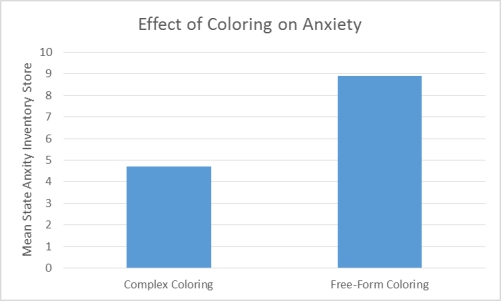Use the following to answer questions
Scenario I
Scenario I is based on fabricated data inspired by the following study:
Curry, N. A. & Kasser, T. (2005) . Can coloring mandalas reduce anxiety? Art Therapy: Journal of American Art Therapy Association, 22(2) 81-85.
Effect of Coloring on Anxiety
Curry and Kasser were interested in examining whether coloring complex geometric patterns reduces anxiety. To that end, they induced anxiety in 84 undergraduate volunteers from their university. Following anxiety induction the participants were divided into two coloring conditions. To determine which condition each participant would be in the researchers put all of their names in a hat. The first name drawn was placed in group 1, the second name drawn was placed in group 2, the third name drawn was placed in group 1, and so on. Those in the complex geometric coloring condition (group 1) were given a paper with a plaid pattern or the outline of a mandala. Those in the control condition (group 2) were given a blank piece of paper. After 20 minutes of coloring all of the participants completed a self-administered State Anxiety Inventory (SAI) . Lower SAI scores indicate low levels of anxiety whereas higher SAI scores indicate high levels of anxiety. The mean SAI scores of each coloring condition were compared to determine whether the type of coloring one does affects anxiety. The results revealed that those who colored a complex geometric pattern had significantly different levels of anxiety than those who colored on a blank sheet of paper. Curry and Kasser concluded that coloring causes a change in anxiety, but only when coloring requires a certain amount of attention and focus.
Figure 1. Effect of Coloring on Anxiety

-(Scenario I) Let's say you are skeptical of the results of this study. You set out to replicate it to determine for yourself whether coloring affects anxiety. Since you don't have access to the State Anxiety Inventory you decide to measure participants' heart rate instead. In doing this, you have changed:
Definitions:
Doublet
A pair of closely spaced lines or peaks observed in spectroscopy or other forms of analysis, indicating two related quantum states.
Singlet
In spectroscopy, a singlet represents a state in which all the electron spins are paired, leading to no magnetic spin multiplicity in the atomic or molecular orbital.
Proton Spin Decoupled
A nuclear magnetic resonance technique where the interaction between hydrogen nuclei and neighboring nuclei is removed to simplify the spectrum.
Triplet
In chemistry, a molecular entity with three similar elements or functional groups in its structure or a magnetic quantum state distinguished by three levels.
Q3: You are interested in conducting a research
Q6: (Scenario II)Based on the information provided in
Q7: Which of the following is the
Q10: A researcher is interested in what behaviors
Q14: Professor Mateo is designing an experiment to
Q16: How might a researcher engage in triangulation?<br>A)
Q20: A value that best represents all of
Q34: A 2010 study investigating whether darkness increases
Q49: If two scales are purported to measure
Q71: Which of the following is the appropriate